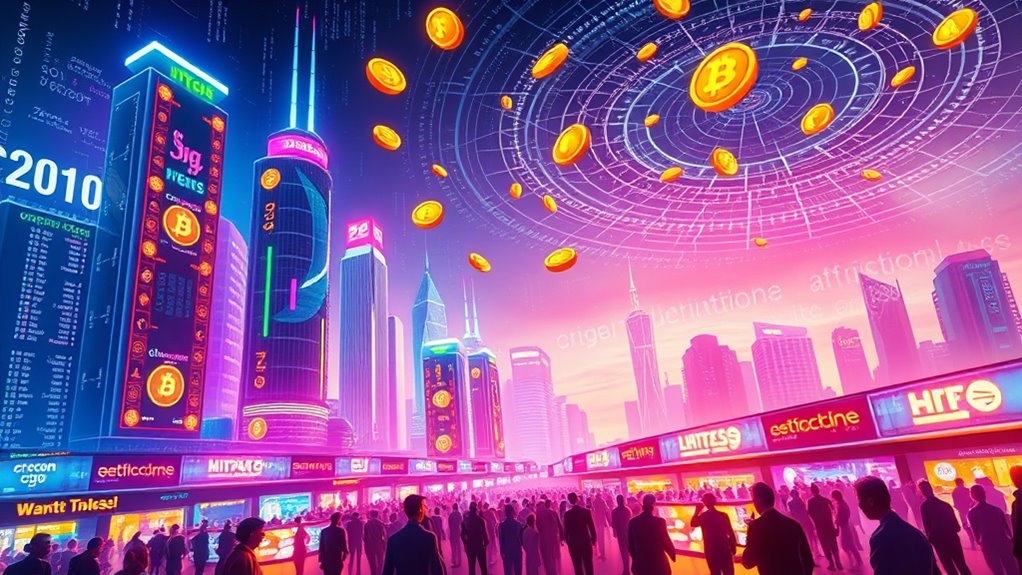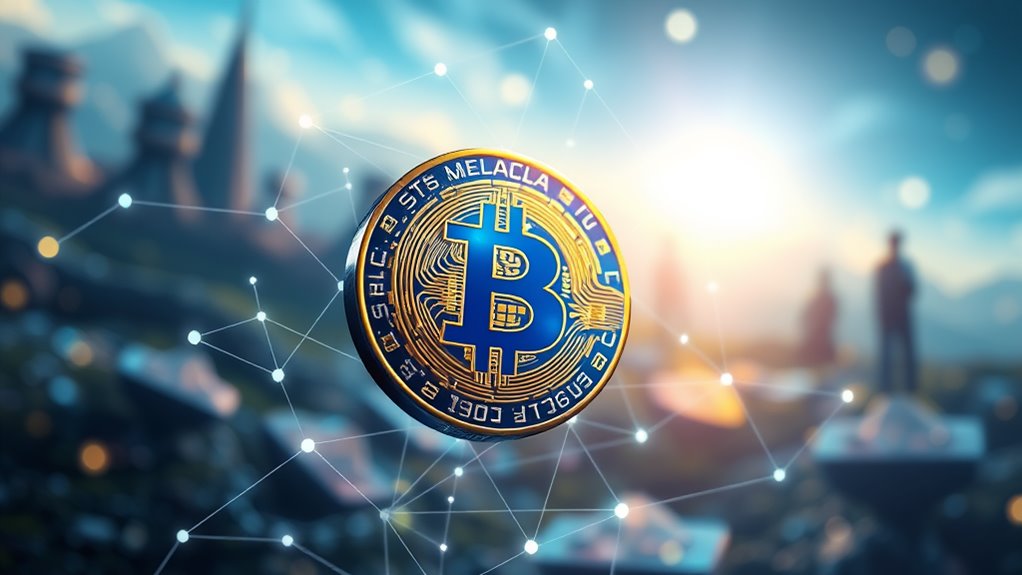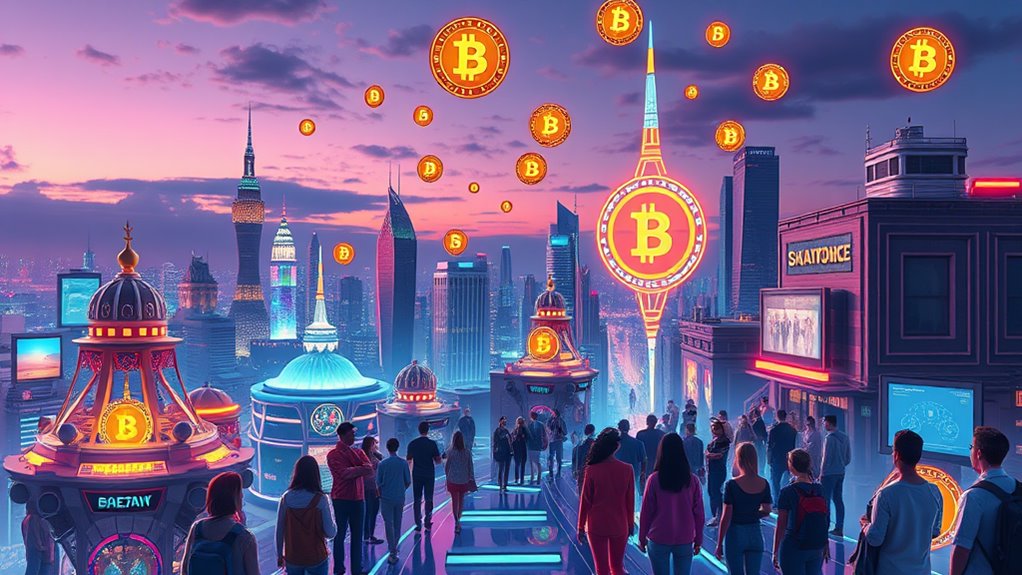
Metaverse Crypto Tokens: What They Are and How They Work
Metaverse crypto tokens are digital assets utilized within virtual environments, built on blockchain technology to guarantee security and transparency. These tokens facilitate transactions for virtual land, in-game items, and other digital assets, thereby supporting virtual economies. Examples include Decentraland (MANA) and The Sandbox (SAND), which allow users to buy and sell digital properties. As the ecosystem evolves, understanding their function and impact becomes increasingly important for users and investors alike. Explore further to discover more insights.
Key Takeaways
- Metaverse tokens are digital assets used in virtual environments for transactions, enabling users to buy, sell, and trade digital assets securely.
- Built on blockchain technology, these tokens ensure transparency, security, and decentralization in virtual economies.
- Popular examples include Decentraland (MANA) and The Sandbox (SAND), which support virtual real estate and asset creation, respectively.
- Token holders can participate in governance decisions and access exclusive services within the metaverse ecosystem.
- The price and investment potential of metaverse tokens fluctuate based on user demand, market trends, and regulatory changes.
Definition and Purpose of Metaverse Tokens

Metaverse tokens serve as crucial digital assets within virtual environments, enabling various transactions and interactions. These tokens are built on blockchain technology, which guarantees transparency, security, and decentralization.
They can represent different assets, such as virtual land or in-game items, contributing to the overall functioning of virtual economies. Metaverse tokens facilitate the buying and selling of digital assets while supporting diverse economic activities, including play-to-earn models and leasing.
Additionally, they often grant holders access to specific services within a metaverse, enhancing user experience. Some tokens also allow for governance, giving users decision-making power in the virtual ecosystem.
Ultimately, metaverse tokens play a significant role in creating and sustaining immersive experiences in digital landscapes.
Examples of Popular Metaverse Tokens

Within the digital landscape, various tokens have emerged as significant components of metaverse ecosystems. Notable examples include Decentraland (MANA), a platform for buying and selling virtual real estate, and The Sandbox (SAND), which allows users to create and trade digital assets.
Axie Infinity (AXS) attracts players to its play-to-earn model, where users battle digital creatures. Additionally, Floki (FLOKI) supports play-to-earn experiences, while ApeCoin (APE) is integral to the Bored Ape Yacht Club‘s Otherside project.
Other tokens, such as Immutable (IMX) and Gala (GALA), enhance gaming transactions, while Render (RNDR) offers decentralized GPU rendering. Each of these tokens plays a distinct role, contributing to the broader metaverse’s functionality and user engagement.
How Metaverse Tokens Function

As users navigate the digital environments of the metaverse, they encounter various functions of crypto tokens that greatly enhance their experiences.
Metaverse tokens facilitate transactions, governance, and asset creation, which are essential for a seamless virtual experience. Key functions include:
- Transaction Facilitation: Users buy, sell, and trade digital assets securely using cryptocurrencies, eliminating intermediaries.
- Governance Participation: Token holders can vote on governance matters, influencing platform development through decentralized decision-making.
- Asset Creation and Trading: Tokens allow users to create, invest in, and trade digital assets, fostering innovation.
These functions illustrate how metaverse tokens are integral to user engagement and the overall economy within virtual spaces, ensuring a decentralized and secure environment for all participants. Additionally, the integration of blockchain and smart contracts enhances transparency and security in these virtual economies.
Blockchain Technologies Supporting Metaverse Tokens

Blockchain technology forms the backbone of the infrastructure that supports metaverse tokens, enabling secure and efficient interactions within virtual environments.
This decentralized, immutable ledger allows for transparent data storage and transaction recording, essential for validating ownership of digital assets like NFTs.
Various blockchains, such as Ethereum, Solana, and TRON, play significant roles in this ecosystem, each providing unique features like high transaction speeds and low fees.
Consensus mechanisms, including Proof of Work and Proof of Stake, guarantee transaction validation.
The immutable nature of blockchain prevents tampering, while cryptographic security protects user data. Additionally, Ethereum’s smart contracts automate transactions and enhance the functionality of metaverse applications.
Together, these technologies facilitate decentralized interactions, enhance transparency, and promote trust, creating a robust foundation for the growth of metaverse economies.
Economic and Financial Aspects of Metaverse Tokens

The economic and financial aspects of metaverse tokens reveal important factors influencing their market behavior.
Price volatility, driven by user demand and speculative trading, greatly impacts investment potential and market capitalization trends.
Understanding these dynamics is essential for investors looking to navigate the evolving landscape of virtual economies.
Price Volatility Factors
Price volatility in metaverse crypto tokens is shaped by a variety of economic and financial factors that influence investor behavior and market dynamics.
Key aspects contributing to this volatility include:
- Supply and Demand Balance: Fluctuations in supply can lead to significant price changes.
- Market Sentiment: News and perceptions can create rapid shifts in token values.
- Liquidity and Trading Volume: Higher trading volumes often result in reduced volatility.
Additionally, economic indicators like inflation and funding levels for metaverse projects can affect token stability.
Regulatory changes and the actions of large investors, or “whales,” also play essential roles.
Investment Potential Analysis
Numerous factors contribute to the investment potential of metaverse crypto tokens, making them an intriguing option for both new and seasoned investors. Increased user adoption enhances demand, which can lead to higher token values.
Many projects offer tokens at low prices, allowing early investors to potentially secure significant returns. Additionally, these tokens provide diversification benefits by adding unique digital assets associated with emerging technologies.
The metaverse’s innovative nature suggests long-term growth, appealing to investors seeking sustainable opportunities. Moreover, low-cap tokens, such as LuckHunter, present high-risk, high-reward scenarios for early backers.
As the metaverse economy expands, driven by play-to-earn models and NFTs, the investment landscape for metaverse tokens continues to evolve, attracting increasing interest.
Market Capitalization Trends
As the metaverse continues to evolve, market capitalization trends play a crucial role in understanding its economic landscape. The total market capitalization for this sector reached approximately $6.18 billion, but individual tokens exhibit significant variation.
- Popular projects typically outperform smaller ones in both market cap and trading volume.
- Tokens like the Metaverse Index (MVI) have a market cap of around $2.26 million, highlighting the diversity of projects.
- Market capitalizations are influenced by broader cryptocurrency conditions and specific project news.
These trends reflect the growth of virtual economies, where tokens facilitate transactions and can represent digital assets.
Understanding these dynamics provides insight into the potential and challenges faced by metaverse tokens in the expanding digital marketplace.
Buying and Trading Metaverse Tokens

When individuals seek to buy and trade metaverse tokens, they often start by exploring various cryptocurrency exchanges such as Coinbase, Kraken, or Uphold.
Individuals typically begin their journey into metaverse tokens by exploring popular cryptocurrency exchanges like Coinbase, Kraken, or Uphold.
These platforms typically accept fiat deposits through methods like wire transfers, bank transfers, or credit/debit cards. After funding their accounts, users can select specific metaverse tokens, such as SAND or MANA, for purchase.
Once acquired, tokens are stored in the exchange’s wallet, with the option to transfer them to a personal wallet for added security. It is essential to evaluate potential taxes and fees that may apply, depending on the exchange and jurisdiction. Additionally, beginners may benefit from exploring exchanges that offer educational resources to enhance their trading knowledge.
For trading, platforms like Binance and decentralized exchanges offer various options for buying, selling, and swapping these digital assets.
Future Trends in Metaverse Token Adoption

As the Metaverse continues to evolve, several key trends are expected to shape the adoption of Metaverse tokens.
Increased brand engagement will likely occur as more companies explore opportunities within virtual environments, while enhanced interoperability solutions will enable users to navigate across different platforms more seamlessly.
Additionally, the regulatory landscape is anticipated to evolve, impacting how tokens are used and traded in these digital spaces.
Increased Brand Engagement
How can brands effectively increase engagement in the evolving landscape of the metaverse? As the metaverse continues to grow, companies are exploring innovative strategies to connect with their audiences.
Key approaches include:
- Blockchain-Powered Loyalty Systems: Brands are utilizing blockchain technology to create loyalty programs where customers earn tokens that hold real value, encouraging long-term commitment.
- Exclusive Experiences: By offering limited-edition NFTs and virtual experiences, brands can enhance customer loyalty and engagement.
- Decentralized Governance: Implementing decentralized autonomous organizations (DAOs) allows customers to participate in brand decisions, fostering deeper connections.
These strategies highlight the potential for brands to leverage metaverse tokens to build stronger relationships with consumers, ultimately driving engagement and loyalty in a digital landscape.
Enhanced Interoperability Solutions
In an increasingly interconnected digital landscape, enhanced interoperability solutions are becoming vital for the successful adoption of metaverse tokens. Interoperability allows different platforms to interact and share assets, creating a cohesive virtual environment. However, technical challenges persist, such as varying platform architectures. Blockchain technology plays an essential role by providing decentralized frameworks for tracking digital assets. Innovations like cross-chain systems and open standards facilitate seamless communication between platforms, while smart contracts guarantee consistent governance of digital assets. The following table illustrates key components of interoperability:
| Component | Description | Impact |
|---|---|---|
| Cross-Chain Systems | Connect different blockchains for asset transfer | Increased fluidity |
| Open Standards | Enable effective communication between platforms | Enhanced user experience |
| Blockchain Domains | Access multiple platforms with a single identity | Simplified navigation |
| Smart Contracts | Govern digital assets across platforms | Consistent rules |
Regulatory Evolution Impact
Regulatory evolution considerably impacts the adoption of metaverse tokens, affecting both their use and acceptance in digital environments.
The current regulatory landscape presents several challenges that influence the future of these tokens:
- The absence of specific guidelines leads to confusion, as existing laws can be difficult to enforce due to anonymity.
- Regulatory frameworks vary across jurisdictions, complicating compliance for businesses operating within the metaverse.
- Increased scrutiny from regulatory bodies, such as the SEC, may classify certain assets like NFTs as securities.
As governments work toward clearer regulations, metaverse tokens could gain wider acceptance. Recent developments, such as the SEC’s shift in its approach to asset classification, suggest that clarity will foster innovation and investment, providing a more secure environment for users and developers while defining the tokens’ roles as both currency and investment tools.
Frequently Asked Questions
How Do I Choose the Right Metaverse Token to Invest In?
To choose the right metaverse token, one should evaluate its use case, market performance, liquidity, blockchain infrastructure, and community support, ensuring alignment with personal investment goals and risk tolerance in a rapidly evolving landscape.
Can Metaverse Tokens Be Used Outside of Their Specific Platforms?
In the world of digital currencies, not all that glitters is gold. While some metaverse tokens can function beyond their platforms, their usability often hinges on exchange listings and specific blockchain interoperability, limiting broader application.
What Is the Environmental Impact of Metaverse Tokens?
The environmental impact of metaverse tokens is significant, primarily due to greenhouse gas emissions from energy-intensive blockchain processes. Shifting to renewable energy sources and improving energy efficiency are essential to mitigate these ecological challenges.
How Are Metaverse Tokens Taxed in Different Countries?
Tax treatment of metaverse tokens varies considerably across countries. While some nations offer exemptions or low rates, others impose capital gains taxes, complicating compliance for holders engaged in trading or utilizing these digital assets.
What Are the Risks of Losing Metaverse Tokens in Hacks?
The risks of losing metaverse tokens in hacks include asset removal, unauthorized transfers due to smart contract flaws, insufficient security measures, user errors, and the challenges posed by the decentralized nature of metaverse ecosystems.
Conclusion
In summary, metaverse crypto tokens represent a significant advancement in digital finance and virtual interaction. They serve various purposes, from facilitating transactions to enhancing user experiences within virtual environments. As blockchain technology evolves, these tokens are likely to become as ubiquitous as smartphones in daily life. Understanding their function and potential is essential for anyone interested in the future of digital economies. The ongoing developments in this space will shape the landscape of virtual reality and digital ownership.












